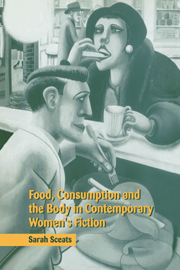Book contents
- Frontmatter
- Contents
- Acknowledgements
- Introduction
- Chapter 1 The food of love: mothering, feeding, eating and desire
- Chapter 2 Cannibalism and Carter: fantasies of omnipotence
- Chapter 3 Eating, starving and the body: Doris Lessing and others
- Chapter 4 Sharp appetites: Margaret Atwood's consuming politics
- Chapter 5 Food and manners: Roberts and Ellis
- Chapter 6 Social eating: identity, communion and difference
- Conclusion
- Notes
- Bibliography
- Index
Chapter 5 - Food and manners: Roberts and Ellis
Published online by Cambridge University Press: 22 September 2009
- Frontmatter
- Contents
- Acknowledgements
- Introduction
- Chapter 1 The food of love: mothering, feeding, eating and desire
- Chapter 2 Cannibalism and Carter: fantasies of omnipotence
- Chapter 3 Eating, starving and the body: Doris Lessing and others
- Chapter 4 Sharp appetites: Margaret Atwood's consuming politics
- Chapter 5 Food and manners: Roberts and Ellis
- Chapter 6 Social eating: identity, communion and difference
- Conclusion
- Notes
- Bibliography
- Index
Summary
Food is an essentially social signifier, a bearer of interpersonal and cultural meanings. It is, and has been, constructed as symbolic in all sorts of ways, either intentionally (Passover, the Eucharist), through custom (harvest suppers and hot cross buns) or by commerce (the ‘ploughman's lunch’); the resonances are, initially at least, culture-specific. (These resonances may change, of course: hot cross buns began their life in ancient Egypt as bread marked with horns for fertility.) Both the acceptability of particular foods and what they signify are part of cultural identity. Not only might raw fish, witchetty grubs or blancmange be repellant to people from cultures that do not eat such things, the cachet or dreariness of a particular dish or titbit is likely to be overlooked by outsiders. What, for example, might a passing Martian make of a cake topped with burning candles?
The socially constructed significance of food is many-layered, and increasingly multicultural. Peter Farb and George Armelagos claim that since eating is something we normally do every day, it is a major means of self-definition, as well as an important channel for the transmission of culture, eating habits being the most conservative of behaviour patterns. Eating is influenced, they claim, by the whole cultural system: by the means through which a society adapts to and exploits its environment; by social structures created for order and to train the next generation; and by ideology, the world-view of the particular society.
- Type
- Chapter
- Information
- Food, Consumption and the Body in Contemporary Women's Fiction , pp. 125 - 154Publisher: Cambridge University PressPrint publication year: 2000
- 1
- Cited by

